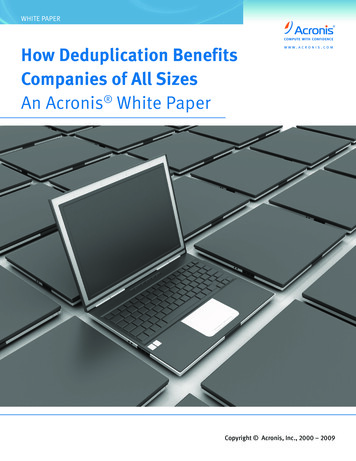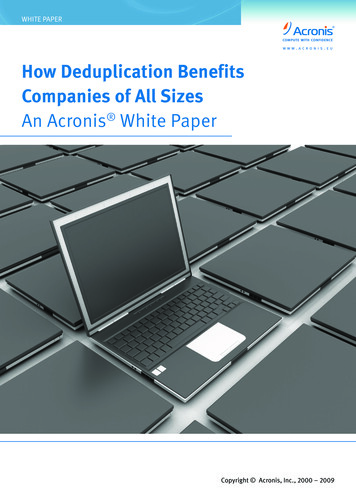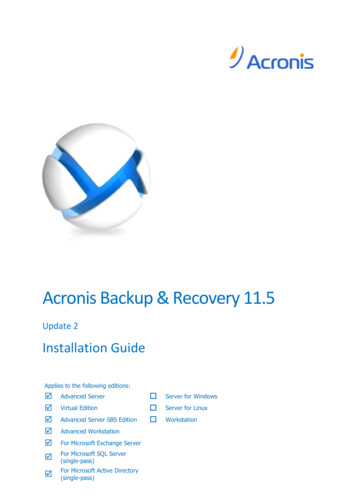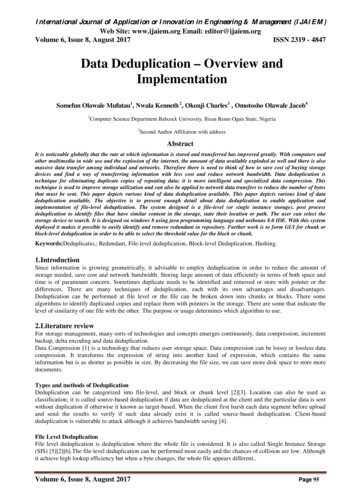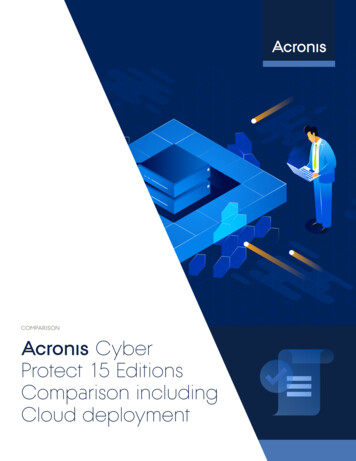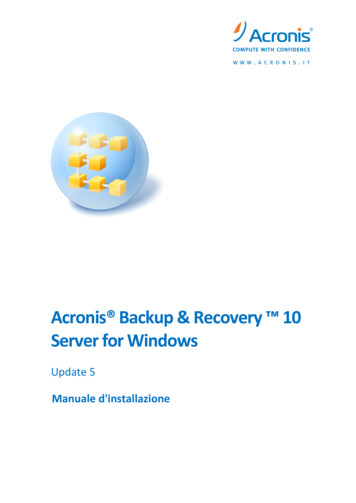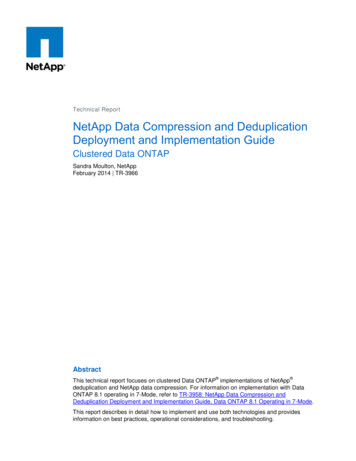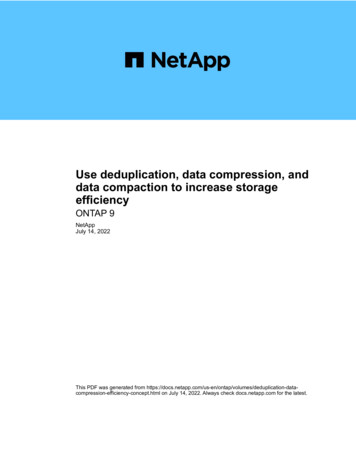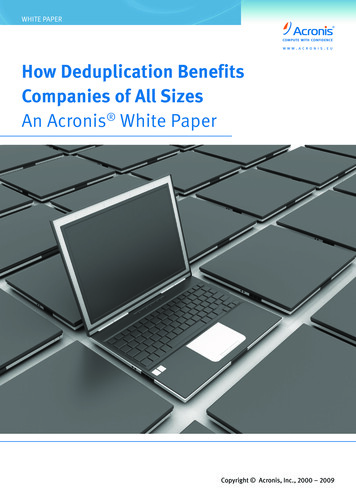
Transcription
WHITE PAPERHow Deduplication BenefitsCompanies of All SizesAn Acronis White PaperCopyright Acronis, Inc., 2000 – 2009
WHITE PAPERTable of contentsExecutive Summary . 3What is deduplication? . 4 File-level deduplication Block-level deduplication Addressing security concernsHow can deduplication benefit your organisation? . 5 General benefits Source duplication benefits Target duplication benefitsSummary. 7Introducing Acronis Backup & Recovery 10 deduplication . 7 Acronis Deduplication advantages Quick hash algorithm: key to performance-optimised source deduplication Securing deduplicated dataTaking the next step . 102
WHITE PAPERExecutive SummaryPrimary storage in small and large companies alike is growing at 50% - 100% a year. And, according to IDCresearch conducted in the second half of 2008, the amount of global digital data created and stored on aworldwide basis has increased over 3,000% in just three years. In addition, many multiple-site organisationsare working to consolidate data assets along with system consolidations (including virtualisation) to create aless energy-intensive collection of assets that fit in a reduced physical space.Carrying costs associated with storing and managingall that data on disk or tape can be cut dramatically by deduplication.The benefits of data deduplication have been well publicised; but in the most basic sense they enable anorganisation to: store far more backup data for a given expenditure or substantially lengthen disk purchase intervals, store to disk cost efficiently, taking advantage of its speed and eliminating the need for tape effectively reduce its backup window.If deduplication is such a cost effective data reduction technique, why doesn’t every IT organisation use it? Untilrecently, the cost of proprietary hardware deduplication products has priced large and small organisations outof consideration. That same cost concern forced the relatively small percentage of organisations who couldafford it to reserve it only for server data, despite the fact that workstation data frequently represents half of theentire data owned by an organisation. However, the advent of software-only deduplication has substantiallylowered the threshold for purchase, making it attractive to organisations of all sizes, and allowing workstationdata to be deduplicated as well.In this white paper, we’ll define deduplication, detail its benefits and make a business case for using it inWindows and Linux environments3
WHITE PAPERWhat is Deduplication?Deduplication is designed to eliminate redundant data in a storage system, and it is designed to reduce theamount of data that must be stored as a backup. It can act at the file or block level.How do these levels differ?File-level DeduplicationFile-level deduplication searches for any files that are exactly alike and stores only one copy, placing ‘pointers’in place of the other copies. While file deduplication is more efficient than no deduplication whatsoever, evena single minor change to the file will result in an additional copy being stored.Block-level DeduplicationBlock-level deduplication promises much greater overall storage efficiency. It works by searching for instancesof redundant information by looking at chunks of data sized 4KB and larger and stores only one copy, regardlessof how many copies there are. The copies are replaced by pointers which reference the original block of data ina way that is seamless to the user, who continues to use a file as if all of the blocks of data it contains are hisor hers alone.Deduplication cuts data storage volume by as much as 90%.To illustrate the power of deduplication, consider the impact on your back up system when you email a Microsoft Powerpoint presentation, full of graphics and eating up 9 MB of space, to 10 colleagues in your company. Whenyou push the ‘send’ button, you clone 10 copies of that 9 MB file. When each recipient’s data is backed upusing traditional techniques, each instance of the presentation is backed up and stored. Suddenly a 9 MB filenow occupies 99 MB of backup storage. Multiply this by hundreds of other instances of data cloning that occurthroughout each day and you start to understand why disk storage requirements, and resulting costs, haveclimbed so steeply.Deduplication is a proven way to reduce initial storage acquisition costs while saving network bandwidth. Itmakes it possible to either increase the data storage capacity per storage unit (stretching the time betweenadditional data storage purchases), or to retain online data for longer periods of time.Users might start to invest more—not just in raw capacity, but on tools that wouldhelp to maximise storage utilisation [e.g., thin provisioning, data deduplicationand storage virtualisation].Natalya Yezhkova, Research Manager, storage systems, IDC. January 20094
WHITE PAPERThe whole process (left) can be carried out as a: Source function where duplicates are eliminated before they are written to a target disk Target function that identifies duplicate data already written to disk and removes them.Why is it important?For many companies, deduplication will reduce data volumes so substantially that all backups can be kepton disk, obviating the need for tape and offline tape storage except perhaps for long-term archives. With thistransition, administrators can accomplish faster backups and recoveries inherent with disk-based data protectionsolutions. Deduplication also makes it easier to meet government and financial reporting requirements, havingto store all the copies that would be generated over a several years.Addressing Data Integrity ConcernsWhile deduplication can save vast amounts of disk space, its very concentration makes it critical to store itproperly. If a data block found on several sources (as in our earlier example of the Powerpoint presentation)is deduplicated and then lost, all of the backups associated with it will be damaged, since the source data isnow non-existent. It applies to full system backups as well. If disaster strikes, a single damaged data blockcorresponding to a vital part of a Windows OS will make all the backups unusable for a system recovery. Pleaseconsider using RAID array to store deduplication data to provide an extra level of protection.How Can Deduplication Benefit Your Organisation?General BenefitsDeduplication promises that organisations can store many times as much data per storage unit than before.Alternatively, for the same expenditure, they can chose to retain online data for longer periods of time. Eitherway, it translates into several business benefits: effectively increased network bandwidth - no copies need to be transmitted over the network ifdeduplication takes place at the source a “greener” environment - less electricity, fewer cubic feet of space required to house the data in bothprimary and remote locations faster recoveries ensure that line-of-business processes continue unimpeded preserves the ability to respond to legal and corporate data storage compliance requirements withoutadding storage bloat fast return on investment - because you’re buying and maintaining less storage smaller backup window, backing up pointers to the data rather than the data copy itself takes only a tinyfraction as much space. lower overall cost of storage - because you’re storing less5
WHITE PAPERSpecific Advantages of Source DeduplicationSource (or server-side) deduplication (shown in the top part of the following graphic) can: reduce the amount of data transferred over a network to a target storage location by 10 to 20 times eliminate a potential transmission bottleneck, particularly in scenarios where existing networks are alreadyrunning at near capacity or where you are carrying out remote office backups over limited-bandwidthcommunications lines be effective for all types of stored data whether they are application-aware or not be easier to implement, as it doesn’t require additional hardware or clients on the target sideIts main disadvantage?Backups can take longer and use a lot of CPU cycles in the process of deduplicating data, possibly introducingperformance issues on production machines. However, as we’ll discuss later in the white paper, a new technologycalled performance-optimised source deduplication can eliminate most of source deduplication’s performancetradeoffs.DeduplicationDeduplicated data streamSourceNon-deduplicated data streamSourceTargetDeduplication!TargetSource vs. Target DeduplicationSpecific advantages of target deduplication (bottom part of above graphic).Target deduplication takes place after the source has been backed up, at the target storage location, typicallyon an attached storage node (ASN).Its main advantage?The initial backup at the source can be completed more quickly by moving CPU-intensive deduplication offthe source machine, shortening the backup window. Target deduplication is often preferred in situationswhere administrators are supporting deduplication-unaware clients and data sources, or when the processingoverhead associated with source deduplication will lengthen backup windows beyond the time limits set byadministrators.6
WHITE PAPERIts main disadvantage?All copies that existed prior to deduplication must be sent over the network, potentially causing a bandwidthbottleneck. The choice of source versus target deduplication will depend on which constraint – client CPUprocessing overhead or bandwidth considerations – is most important to your organisation.SummaryDeduplication used to be an exclusive tool of the large enterprise, with an imposing cost, a daunting learningcurve, and – with file-only deduplication – a limited ability to use deduplicated data to restore a failed machine.Until now, deduplication has been too expensive to implement in any but the largest organisations. Moreover,it could be applied only in support of servers, despite the fact that enormous data stores are contained at theworkstation level within most IT infrastructures.Most deduplication products have been designed and sold as combined software/hardware solutions. In mostcases the hardware alone has been difficult to justify because of its high cost. To illustrate the latter, considerthe fact that one well-known vendor reduced the cost of one of its high-end data deduplication appliancesin March 2009 by more than one third. But at a reported 130,000 for 12 TB of storage capacity, it is stillan expensive proposition. Roadblocks like these have limited the promises of deduplication to the largest oforganisations.However, such limitations are finally being swept aside, and deduplication can be specified more broadly: not only by enterprises, but also by many smaller organisations which have very significant data storagechallenges not only on servers, but on workstations as wellIntroducing Acronis Backup & Recovery 10 DeduplicationAcronis deduplication has several advantages that distinguish it from the offerings of many other vendors: Your choice of source or target deduplicationMany organisations need to be able to implement both in different parts of the organisation. File-and block-level backupsFile-only backups severely limit the potential savings possible with deduplication. Fast source deduplicationOften eliminates the need to deduplicate at the target. Acronis has made great strides in reducing CPUoverhead in source-side deduplication, eliminating the need for many organisations to offload the job to targetdeduplication servers or appliances.Affordable. More organisations can now cost-justify deduplication, notonly for their servers, but for their workstations, too. Integrated with Acronis backup and recovery productsWorks seamlessly with Acronis Backup & Recovery 10 software, so deduplicated data is just as well protectedas unduplicated data.7
WHITE PAPERAcronis Backup & Recovery 10 Deduplication is delivered as an optional, fully integrated module for our justintroduced Acronis Backup & Recovery 10 software products. A software-only solution, the Acronis deduplicationoffering may be purchased with these advanced editions of Acronis Backup & Recovery 10: Advanced Server Edition Advanced Workstation Edition Advanced Server SBS Edition Advanced Server Virtual EditionAcronis’ Deduplication AdvantagesUnlike many other deduplication solutions, Acronis supports both source and target deduplication. But it alsodistinguishes itself in several other ways: Image-based backupData can be deduplicated, providing either network or storage savings. Fully integrated with Acronis disaster recovery softwareRecovers files and systems – deduplicated and otherwise – in minutes rather than hours or days. Eliminatesstoring multiple copies of large sources of data, like multi-gigabyte operating systems, in the images. Multi-type backupsDeduplication can be applied to full, incremental and differential backups. Sensible costSoftware-only deduplication from Acronis is affordable. Uses commodity storage hardwareAcronis deduplication bypasses the need for costly proprietary hardware. Installs fastTypically it is up and running in about an hour, rather than in the several days required with hardware/software systems. Easy to useThe same ease of use and reduced training requirements that distinguish Acronis products make Acronisdeduplication a pleasure to set up and use.Unparalleled storage efficiency is a reality, especially when combined with powerful Acronis compressionalgorithms (and other efficiency-oriented features) available in Acronis Backup & Recovery 10.Used in conjunctionwith Acronis’ powerful data compression utility, IT administrators can cut overall data store size further, afterdeduplication, by an average of 50% - 60% depending on file types, creating substantial additional disk storagesavings. An attached storage node can be used to compress the data itself during its repack procedure, liftingthe processing burden from production line servers. Both the Acronis .tib file and the deduplication data storageblocks will be compressed.8
WHITE PAPERQuick Hash Algorithm: key to optimised source deduplicationAcronis delivers a more efficient approach to source-side deduplication. To explain what we’ve done, let’slook at a standard source deduplication algorithm (below). Here, the client software first calculates the datachecksum of the data to be backed up – called hash. This hash is then sent to the target – which responds witheither “I do not have the data” or “I do have the data.” In the first case, the client will send the actual data to thetarget before proceeding with the next portion. In the second case, no further action from the client software isrequired, and the next portion of data may be processed, as shown here.DatatransferFull HashcalculatedDataexists ontarget?Go tonextsegmentYesStandard source deduplicationUnfortunately, standard source deduplication creates significant overhead by always calculating the hash,regardless of whether the target does or does not have the data. This is required because the target cannot tellif the data is already available before the hash is provided by the source. On heavily loaded systems, standardsource deduplication can create a system slowdown that might turn an IT manager against using it at all.9
WHITE PAPERAcronis offers a much-less CPU-intensive approach that makes source deduplication a viable option for mostcompanies. It’s called performance-optimised source deduplication. This powerful algorithm eliminates mostfull hash calculations for data which has yet to be written on the target.NoQuickHashcalculatedDataexists ontarget?DatatransferGo tonextsegmentMay beYesDatatransferFull HashcalculatedDataexists ontarget?NoAcronis performance-optimised source deduplicationIn this approach Acronis first creates quick hash by selecting a small amount of data that is statistically mostlikely to change when the data is modified. Quick hash is very fast, responding either to “I do not have the data”or “I may have the data.” In the first case, the actual data is sent by the client. In the second case, full hash iscalculated, which ensures that the target will respond reliably.For security, we encrypt deduplicated data. One can specify a vault encryption password –protected in Windowssecure storage – during vault creation. The encrypted data is accessible only through that password, and anyattempt to retrieve data from the deduplication data-storage vault will fail without it.10
WHITE PAPERTaking the next stepWhile Acronis is not the first company to offer deduplication, our image-based technology, with its fast backupsand nearly immediate restores, brings deduplication to a new level, applicable to both file and system backupdata, and to servers and workstations. Acronis makes duplication more accessible – both financially and froman ease-of-use perspective – to more users. When used in conjunction with Acronis Backup & Restore 10, itredefines data protection. Here is what you can do to bring deduplication into your organisation:1: T ry our Deduplication Calculator on our website. You can quickly determine just how much you can save usingAcronis Backup & Recovery 10 Deduplication software.2: T ry it for yourself with a trial download. You’ll need to also download Acronis Backup & Recovery 10 in orderto use it.3: L earn more at our website, www.acronis.eu, or call us at one of the numbers listed at the end of this documentfor more details.For additional information please visit http://www.acronis.euUK, Northern Europe and MEA:Central and Eastern Europe:Southern Europe:Acronis Ltd.Tel.: 44 203 1760340Acronis Germany GmbHTel.: 49 89 6137284-0Acronis SASTel.: 33 1 42815531Copyright 2000-2009 Acronis, Inc. All rights reserved. “Acronis”, “Acronis Compute with Confidence”, “Acronis Backup & Recovery” and the Acronislogo are trademarks of Acronis, Inc. Windows is a registered trademark of Microsoft Corporation. Other mentioned names may be trademarks or registeredtrademarks of their respective owners and should be regarded as such. Technical changes and differences from the illustrations are reserved; errors areexcepted. 2009-0611
Acronis Backup & Recovery 10 Deduplication is delivered as an optional, fully integrated module for our just-introduced Acronis Backup & Recovery 10 software products. A software-only solution, the Acronis deduplication offering may be purchased with these advanced editions of Acronis Backup & Recovery 10: Advanced Server Edition
